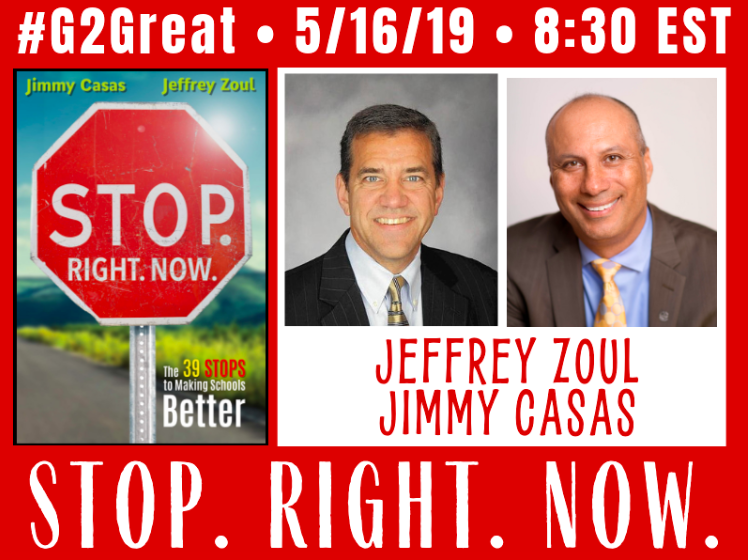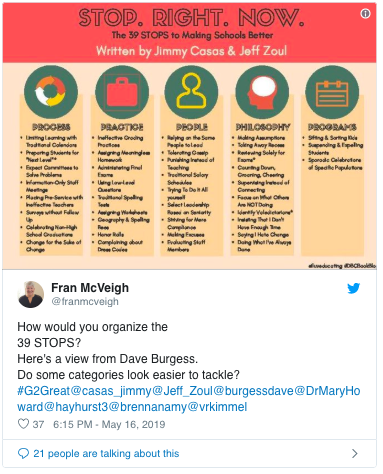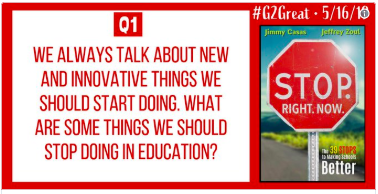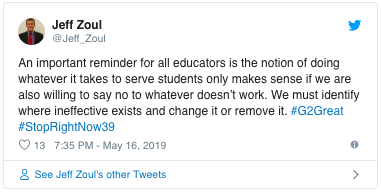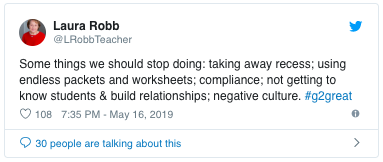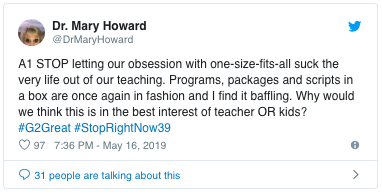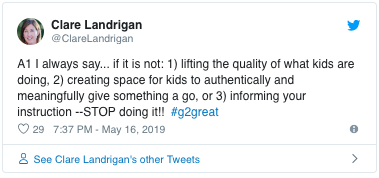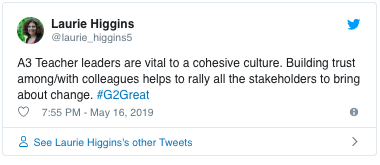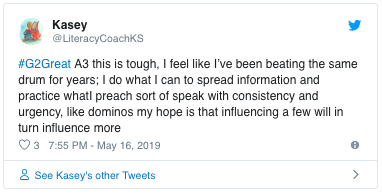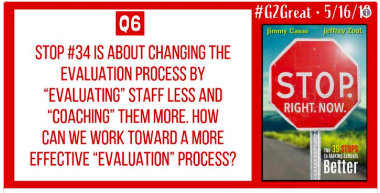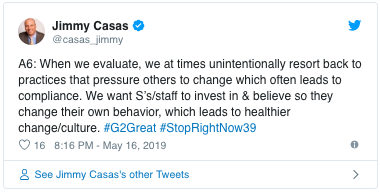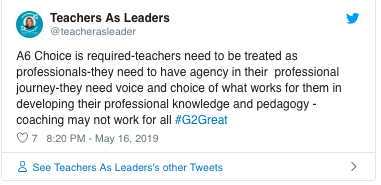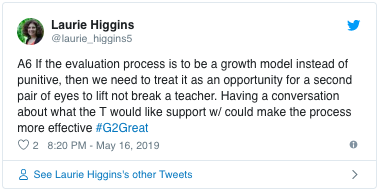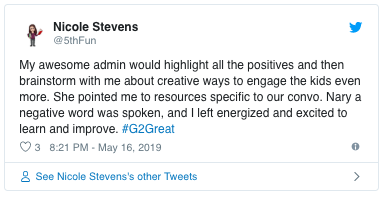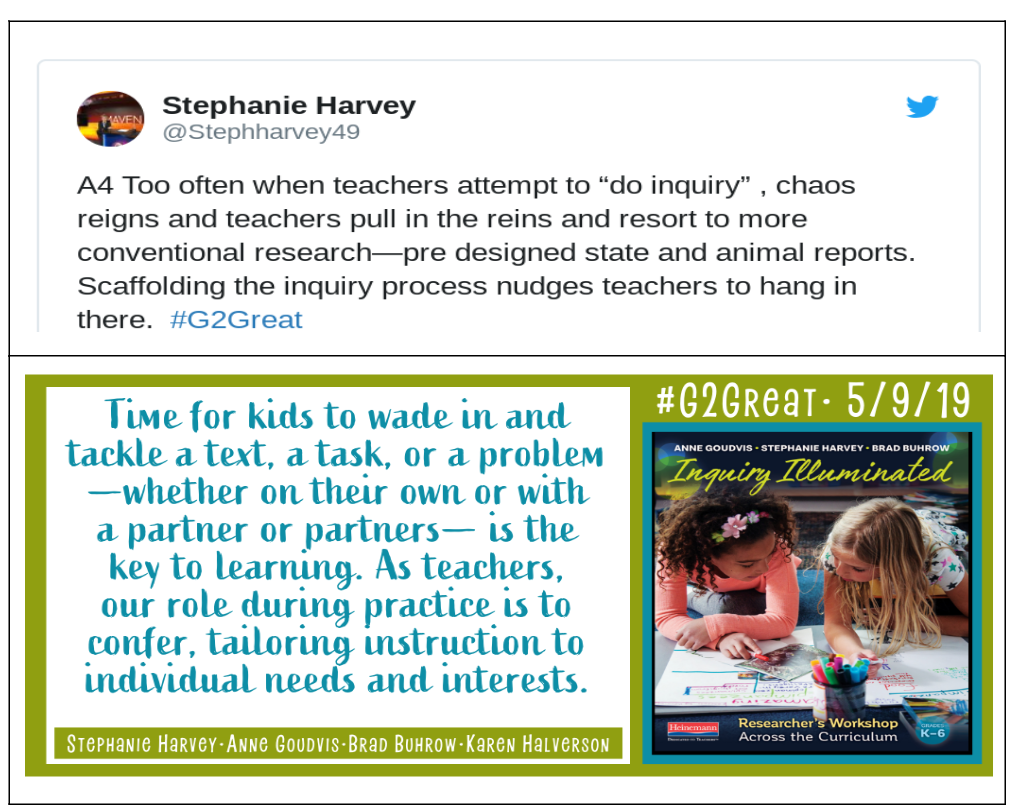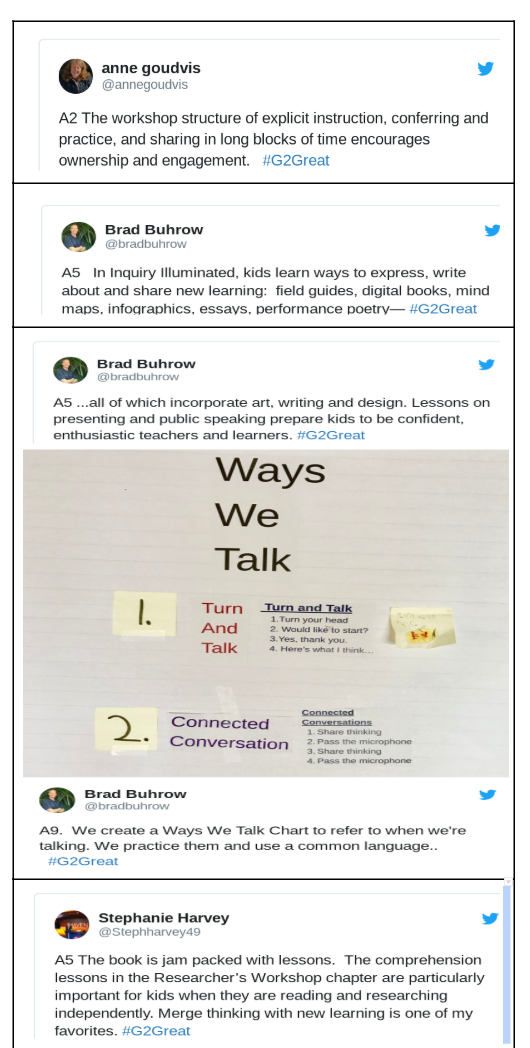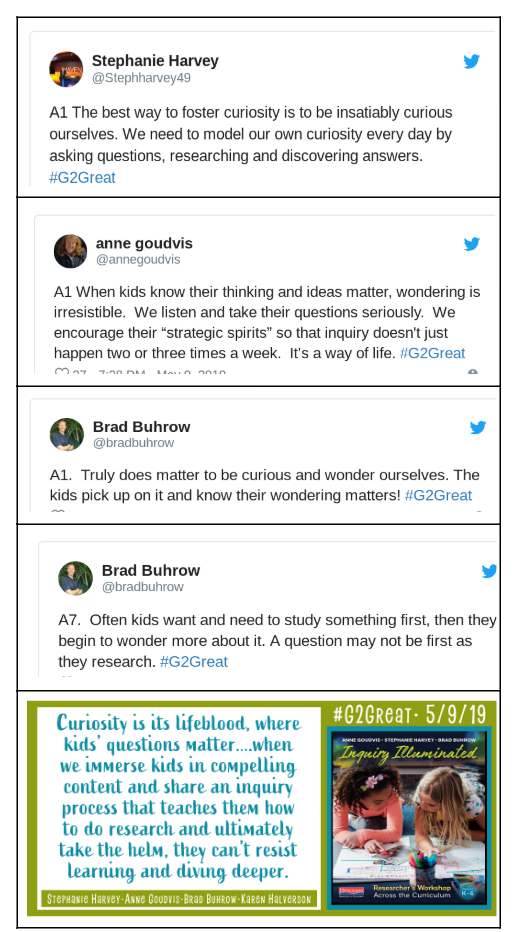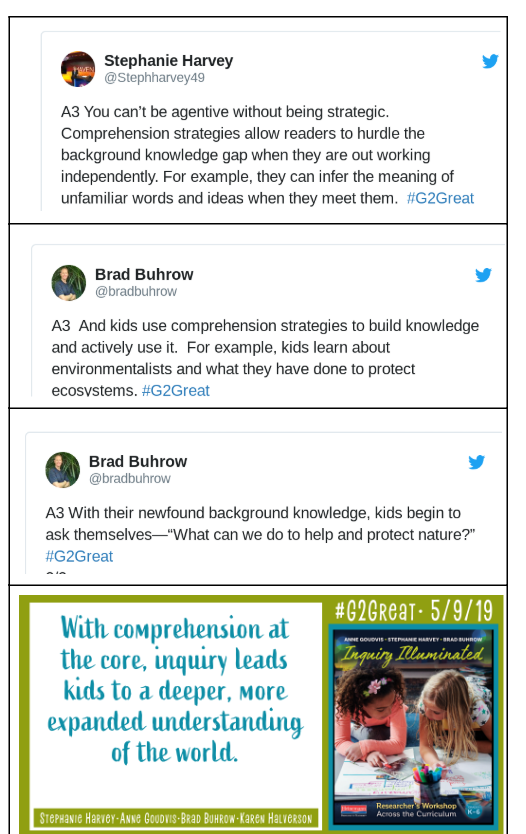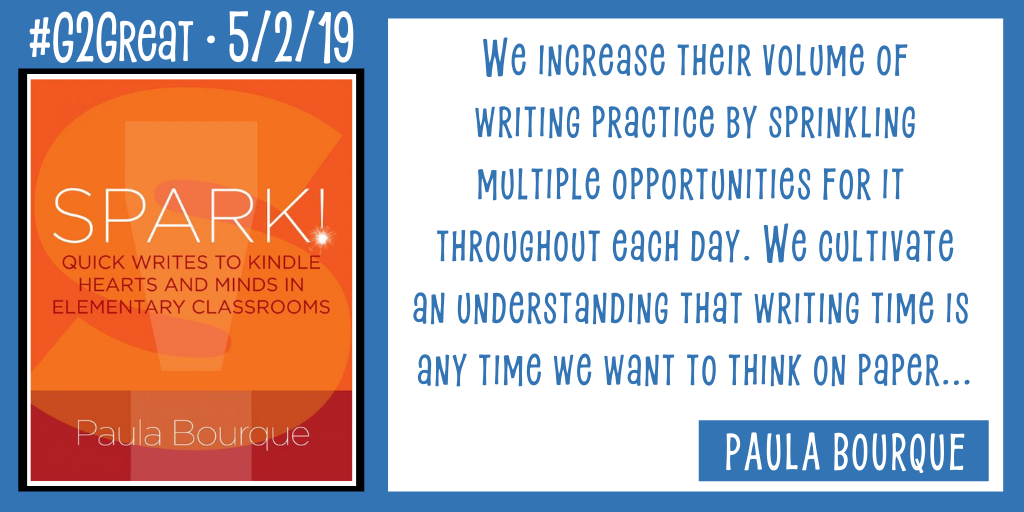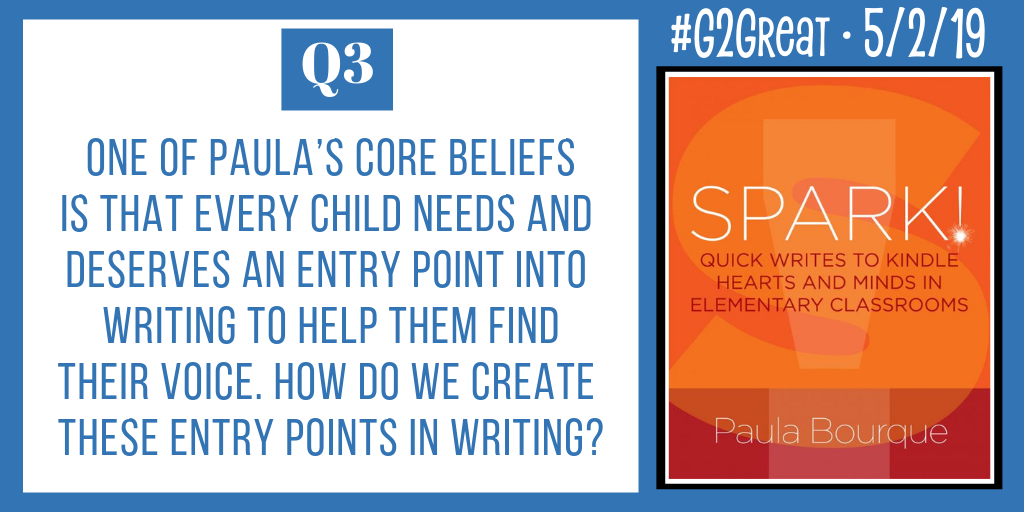by Mary Howard
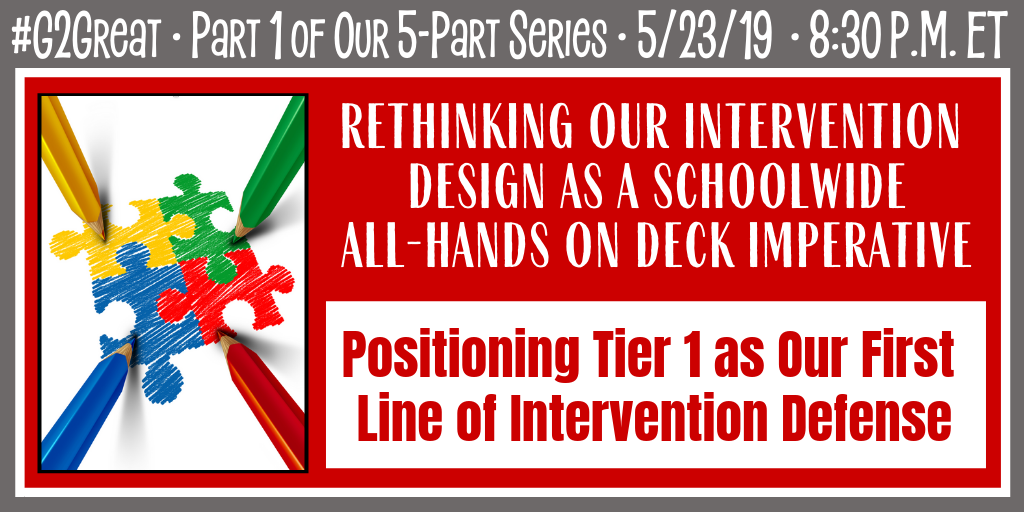
On 5/23/19, we launched the first of a five-week #G2Great chat series: Rethinking Our Intervention Design as a Schoolwide All-Hands on Deck Imperative. We knew that our first exploratory venture of the series should highlight the central intervention feature so we set our sights on Positioning Tier 1 as Our First Line of Intervention Defense. Considering the critical nature of this topic, the passionate twitter dialogue that grew to a fever pitch followed by early twitter trending did not surprise us.
From the first inspired tweet, I felt a sense of gratitude that I was bestowed the honor of writing this post on a topic that is near and dear to my heart. I have been quite vocal about my hopes and fears for Response to Intervention since IDEA 2004 made RTI a reality in our schools. In fact, it was my perpetual two-pronged hope-fear conflict that first prompted me to write RTI from All Sides: What Every Teacher Needs to Know (2009 Heinemann) and since then write extensively about this topic on my Facebook page.
After the chat, I excitedly dug into the inspired tweets as renewed hope quickly rose to the surface along with pride and gratitude for our #G2Great family. That joy was soon clouded by feeling lost in a sea of twitter goodness. After all, making Tier 1 our central intervention feature feels like an overwhelming prospect and yet irrefutably is the most crucial professional imperative of all. I didn’t want to just replicate the not-to-be-messed-with-twitter-wisdom since that’s what our Wakelet artifact is for. While I was utterly inspired by this wisdom, the sense of direction I’d hoped to find was fading.
When my writerly worries rise to the surface as they often do, my coping mechanism usually pushes me to take a side trip to my favorite thinking playground (aka Google). Realizing that accomplishing this lofty Tier 1 as the first line of intervention defense requires us to establish non-negotiables that would transform our imperative into reality, I hopefully tossed the word “non-negotiable” at my google friend. Lo and behold, my new favorite word came instantly into view:

The word sacrosanct felt like it oozed a sense of intervention urgency. I suddenly realized that the best way to approach this post was to narrow my thoughts to a few critical factors we must regard as too important or valuable to be interfered with. Problem solved. Sense of direction back in view.
And so I give you my six “Sacrosanct Priorities” that I hope will offer a thoughtful nudge to ensure that Tier 1 does not continue to get lost in the intervention shuffle, but rather will regain a much deserved role at the very center of our efforts:
Sacrosanct Priority #1: BELIEFS
I can’t imagine how we can ever achieve Tier 1 as the central intervention feature without naming and highlighting the innermost beliefs that we hold professionally dear. I often visit schools and as I enter the building I’m usually greeted by a framed vision statement. While the calligraphy lettering and glowing language are visually impressive on the surface, too often I find a glaring mismatch between what is alluded to in that frame and the reality of Tier 1 on a day-to-day basis. The truth is that these framed papers merely represent shallow words until we are able to verbalize our values so vividly that we can show our commitment to them in the company of children where they matter most. Our beliefs are the promise that we make to our children but they mean nothing until we are able to bring them to life in our classrooms. Making our beliefs public becomes a visible reminder that anything less is simply unacceptable – not in theory but in practice.
Sacrosanct Priority #2: CULTURE
But breathing life into our beliefs does not mean that any teacher can opt out. We do not identify our beliefs so that those who want to embrace them can do so and those who don’t can do whatever they choose even if in direct conflict with those beliefs. We must create a culture of excellence that stretches from from one side of the building to the other so that our children are not relegated to the luck of the draw. Wishing and hoping on every professional star in the belief universe will never turn those beliefs into a culture until we have collective commitment. This means that every teacher must embrace those beliefs so that we can carry them in our back pockets every day we walk into that building no matter who we are. But to do that, we must transform our beliefs into actionable experiences so that those things we value will become the beating heart of the entire building so that we will all be in professional sync. This is especially important at Tier 1 since this is where interventions students will spend the bulk of the day. Why would we make excellence optional?
Sacrosanct Priority #3: TIME
Ah, the great intervention belief killer. I’ve always wondered why most of our interventionists have a healthy respect about our limited time, respect that is not always evident in Tier 1. My theory is that the more we have of something the more we tend to forget just how valuable it is. Wealthy people seem to throw vast money sources away while those without much seem to conserve it. Perhaps this is also true in our schools where those who have thirty precious minutes to spend with children expend that limited time wisely while those who have six hours with children may feel a sense of complacency about some of those minutes. But time is precious no matter how little or how much we may have, especially for students who need more intensive support. Interventions cannot be something that we relegate to any one person. They are owned by all of us and so should happen in the Tier 1 setting. The clock intervention clock is always ticking so we can’t afford to waste a minute no matter how much time we have. The question that begs to be asked at Tier 1 is, “Why are we?”
Sacrosanct Priority #4: INTENT
Based on my extensive work in schools, this unfortunate wasting of time isn’t always the fault of teachers. As long as we mandate belief-sucking, time-wasting culture-killing nonsense that is in direct conflict with what we purport to value, the promise of Tier 1 at the center of our intervention efforts will remain ever out of view. If we force-feed teachers (and thus children) one-size-fits all boxes and computerized programs, interventions that could actually make a difference will be out of reach as we send mixed messages and the very practices that would be thoughtfully responsive for meeting the needs of our intervention students would be out of reach. If we set our sights only on the most effective practices then we’d have a full six hour day to intervene across virtually every curriculum area. Intent allows us to make reading, writing, talking and thinking the heart of our learning day. But this will require us to address the myth of a full day of whole class instruction so that we can we return a balance to Tier 1 with I Do, We Do and You Do experiences that include whole class, small group and side by side teaching and learning. Intent, or choosing experiences that enrich the learning lives of all children all day, creates a culture where our beliefs inform where we spend our time collectively.
Sacrosanct Priority #5: RESOURCES
But in order to make balanced literacy a reality in the Tier 1 setting, we must ensure that we make a financial investment in the resources our Tier 1 teachers need. We can’t embrace beliefs, culture, time, or intent until we provide the resources that support those things. This begins by showering teachers with the books that will enrich the entire learning day across the curriculum. Imagine what would happen if we said “NO” to the $500,000 basal program so that we could say “YES” to investing those dollars in the resources that would make a real difference for teachers and children, such as filling our Tier 1 classroom libraries to brimming. We have decades of research to support the role of dramatically increasing the volume of reading, especially for our intervention students. But until we choose to expend available financial resources on those instructional resources designed to increase rather than decrease volume, we will forever be doomed to repeat past mistakes. We don’t have an intervention problem; we have a commonsense problem. We could start to right this wrong by taking the checkbook away from irresponsible others so that our expenditures reflect our beliefs, not what blinds us to those beliefs, and thus culture, time and intent would follow.
Sacrosanct Priority #6: KNOWLEDGE
But none of those five Tier 1 priorities will ever be possible until we make a commitment to ensure that every teacher in our building has the research-informed knowledge that will fuel the entire learning day. This knowledge guides teacher decision-making and the ability to use formative assessment that will support us in using that research in practice. Our Tier 1 teachers are then far more likely to embrace each of our sacrosanct priorities and far less likely to hit Teachers Pay Teachers activity buy buttons, complain that there isn’t time for independent reading or suggest that a scripted read aloud can come even close to the invitational read aloud that can happen only in the hands of a knowledgeable teacher in the company of curious listeners. Unless we are willing to make ongoing professional learning a high priority every day, we cannot blame teachers for making the choices that derail our efforts to elevate the Tier 1 learning day. Our growing knowledge will fuel our efforts and thus become embedded in all we do, buy, say, think and support when we create a wide range of opportunities for respectful professional dialogue across the learning year in support of ongoing learning.
So, let’s play a little Mary style math here. If you add up my six Sacrosanct Priorities of Belief, Culture, Time, Intent, Resources and Knowledge, you get the ultimate Tier 1 magic:
Child at the Center
And that, my friends, is the Tier 1 united sacrosanct priority at its finest! I believe that the potential for our intervention success rests on our ability to keep Tier 1 at the center. But this requires us to take a long hard look at what has thwarted our path to this point and how we have (or have not) thus far positioned Tier 1 within this process. Our intervention efforts must become a force of good for the children who need them and this resides within Tier 1 where children spend most of their time. The path from 2004 to present has reflected many successes to this end, but that path has also been littered with missteps along the way that are far from the force of good our children deserve. Until we honor those things we regard as too important or valuable to be interfered with, I don’t think Tier 1 will ever be positioned as our first line of intervention defense. And that would be a tragedy of epic proportions.
And so we stand at the crossroads once again…
We are at a crossroads. We can either use response to intervention as an opportunity to rebuild a positive climate or allow it to devolve into something that takes us even farther from the reason most of us became teachers.
Mary Howard, RTI from All Sides, Heinemann, 2009, page 2
Where we go from here is entirely in our hands, but I believe that if we could initiate the same kind of inspired dialogue we all witnessed on Twitter May 23, 2019 from 8:30 to 9:30 EST… well, then we would stand a chance to alter the course of our Tier 1 efforts and ultimately meet the intervention promise that I first saw in 2004. But that will never happen unless Tier 1 is leading the way as we alleviate our view of thirty-minute fix-it rooms and opt to re-envision a full day where Tier 1 can become our intervention superpower.
As we stand at the intervention crossroads, it is my deepest hope that we choose the Tier 1 priority pathway. Anything less robs children of our best hope – a classroom teacher who should know their intervention needs more than anyone.
And that makes the Tier 1 teachers sacrosanct, doesn’t it?
